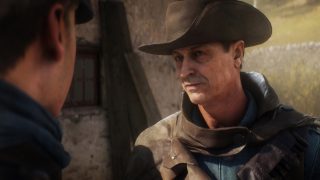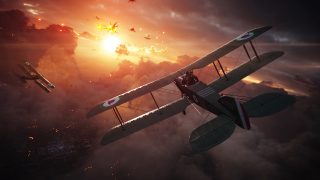Developer Q&A: Writing for Battlefield 1

Are you a fan of the Single Player in Battlefield 1? You’re not alone. Taking place all over the world, conveying many different destinies of the war effort’s men and women, the War Stories are unlike anything in the Battlefield franchise history.
We sat down for a Q&A with Battlefield 1 Lead Writer Steven Hall to learn how the War Stories were created. Read on to go behind the scenes of the most unique Battlefield campaign yet.
Tell us about your role on Battlefield 1 Single Player. What did a “typical day” look like when working on the game?
STEVEN HALL: “I worked with the DICE team in Stockholm to create the stories, characters, and scripts for the Battlefield 1 War Stories – and there were no typical days! I spent some very intense weeks working with the team on initial concepts, and then I wrote treatments to bring out the characters and the drama of what we had.
After that, I spent a lot of time working with the very talented Eric Holmes, Single Player Design Director. He’s a gameplay guy who also has a great story sense, and I’m a story guy with just-about-passable gameplay knowledge, so we kind of met in the middle and weaved story and gameplay together to form a blueprint for each War Story.
I then wrote the scripts based on our blueprints and worked with the cinematic directors and our performance director to make everything as strong as possible. It was a very collaborative process but DICE also gave me the space I needed and let me run with the ball when I felt that was important, which was fantastic.”

The single player campaign has been praised for its somber tone and respectful attitude towards World War 1. How did you find that balance between serious and light-hearted storytelling?
“It all boils down to being as honest as possible with the characters, and letting them behave like real human beings. Real people can be funny, brave and heroic, but also unsure, terrified, treacherous and downright contradictory. The War Stories have their fair share of adventure and daring-do, but when things get serious or horrific I wanted the characters to react in ways that seemed honest and truthful to who they were. That seemed like the best way for us to be respectful to the era.
The story outcomes were designed to be honest and truthful too. There are no medal ceremonies; nobody really “wins” anything in our stories. The victories are small and personal, and the defeats are too. Our Harlem Hellfighter had a line that went something like “The newspapers talk about empires and nations, but I never saw Germany on the battlefield, or heard France screaming from its wounds. All I saw out there were people.” That’s the approach the team and I wanted to take.
World War 1 was so huge and horrific that the numbers don’t really sink in. You can’t really process them, or at least, I can’t. But if players can empathise with a single character’s reactions, then perhaps we can make some small, honest connection in that way.”

Was there an all-encompassing theme or tone to the writing that was agreed upon?
“Tone is a difficult thing. We wanted to be honest and respectful, but as you said, we didn’t want to be relentlessly dark either, even in such a dark place. I think that the writer’s biggest and trickiest job on any project is finding the mood of the thing, fixing it at the right level, and then maintaining that mood, or knowing when to vary it for the best effect. The writer’s work comes first in the story process, so if the writer gets that mood wrong then everything that grows out of those scripts will feel out of tune.
Finding a good tone at the script stage is no magic bullet though. It’s just the first hurdle. You can’t talk about the tone of the War Stories without talking about the amazing visual work our cinematic directors pulled off. As well as being beautiful and filmic, there are hundreds of little things – like the way the shadow from Townsend’s cap hides his eyes in the later parts of Mud and Blood – that really drives the tone in brilliant, subtle ways.
And then we had Tom Keegan, the performance director, who was a huge asset in helping to bring out that honesty I spoke about earlier, and who worked with the actors on set to help them find it in their performance. And across all of Single Player we had Eric Holmes, who kept all the sections of this huge orchestra – not just our story team – playing the same tune, and ensuring that everything stayed consistent. That he kept all these different people with different expertise and responsibilities so tightly together is a heck of an achievement. Eric has to take full credit for that.“

What kind of possibilities - and challenges - did the War Stories concept entail for you as a writer?
“As for possibilities, it allowed for a range of protagonists and viewpoints, and it allowed each War Story to be the shape that it wanted to be, with each one having a proper beginning, middle and end. The War Stories concept allows story to dictate the structure rather than the other way around – i.e. forcing us to artificially stretch a single storyline across hours and hours of campaign.
On the other hand, the War Stories format is a lot more work! Instead of finding a single ending, you’re trying to find half a dozen, and that’s the same with every aspect of the storytelling. It’s so much stronger as a format though. It’s a gift for a writer, and for all of us working with the narrative.”

Did you ever consider doing a story with just one character or were the War Stories a given from the get-go?
“When I arrived at DICE, I was ready to make the case for multiple protagonists, but they were way ahead of me. The episodic format was already taking shape there, and not just because it’s the best storytelling medium, but in terms of player choice and a whole lot of other things too. It all felt very fresh and new, and fantastic for me as a writer. There was briefly an idea to include a framing narrative, but once we took the plunge and went all in on standalone short stories, we never looked back.”

Do you have your own personal favorite War Story, scene, or character?
“It’s hard to pick one, but by personal favorite has to be Clyde Blackburn in Friends in High Places. I love that guy, and I’m so pleased that we never make excuses for him or try to justify him at all. He just is who he is. I’m blown away by the final moments of Friends in High Places every time I see them – the direction, the performance, the edit… It’s all so strong and it completely nails what I was trying to achieve on the page.
That’s the good thing about working with great people. Once the game’s done and you stop obsessing about your own particular part of the puzzle, you can just sit back and enjoy all those great things that everyone else made.”
